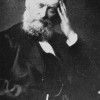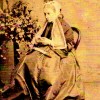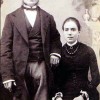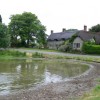The history of clock-making or horology is one of a constant battle to improve the means of timekeeping. Craftsmen in Dorset no less reflected that in their work from the earliest beginnings in the 11th and 12th centuries to the decline of hand-made clocks in the 19th century.
The earliest clocks ever made in Dorset (as probably elsewhere) were those made for churches. During medieval times smaller versions of church clocks were being hand-made for the home elsewhere in the country, but this type was unknown in Dorset. However these clocks would have been very poor timekeepers until technical advances such as the pendulum in the 17th century enabled timepieces to become reliable enough for use in the home.
By the end of the 18th century and from then until the mid-19th century technical refinement and reliability in hand-made clocks reached as far as it would ever go. Henceforth a steady decline in standards set in with the arrival of the Industrial Revolution and mass production.
Dorset exactly reflected this pattern. Its earliest known clock is that residing in Wimborne Minster, dating from 1409, though it is quite possible that this clock or another was in use well before this date. But the earliest sources of our knowledge of clocks in the county come from Churchwarden’s records. These list the names of the clockmakers and repairers – or blacksmiths or whitesmiths – who maintained church turret clocks for over 100 years.
As to when horology became clearly defined as an industry in Dorset, this is difficult to place. For example, when the borough of Dorchester organised its trades into guilds some clock-makers, though included, elected to be registered as braziers or ironmongers as late as the 19th century.
One place where the clock-maker/blacksmith connection can most clearly be seen is in Stourton Caundle parish church. A funerary hatchment of John Biddlecombe bearing the arms of the Worshipful Company of blacksmiths hangs in this church and states “With hammer in hand all artes do stand.” The blacksmith and clock-maker records were lost in World War II but an earlier John Biddlecombe left his blacksmith and clock-working tools to his son upon his death in 1741. The hatchment therefore probably commemorates John junior, who in fact made the church clock still in use today. Indeed, Biddlecombe was just the first in a long succession of smiths to style themselves as clock-makers as well.
One interesting instance of wounded pride has survived showing how clock-makers would consider themselves a cut above other trades. In a letter written in 1772 James Norman, a Poole-clock maker, replies to a complaining minister or churchwarden about his charge for installing a church clock that includes this line: “You may get bunglers or white or blacksmiths to work at a cheaper rate!” Early turret clocks needed constant attention and repair, and as public clocks the cost of their purchase and maintenance was accountable.
A little later than the earliest Wimborne record, accounts of churchwardens in Bridport record a clock in 1425 and in Corfe Castle one is recorded in 1570. It is further noted that Weymouth and Melcombe Regis bought a new clock for St. Mary’s church in 1619. In this instance the maker kept the old clock’s movements in part exchange, indicating that the church’s first clock went back at least 70 years before the replacement. It is not known whether or not these clocks were made in Dorset.
By the 18th century church clocks were being signed and dated. The earliest known signed and dated clock is that set into the tower of Sydling St. Nicholas Church and is inscribed “1593 E.T.C.”
There is no record of a domestic clock in Dorset until the 16th century, but by 1620 records show that the county clearly had clock-makers, and from then a comprehensive list of makers can begin. The earliest records are in the Dorchester Domesday Book at the time of Henry V till Elizabeth I, and the first mention of a clock-maker in the borough records minute of 15th September 1625. As expected the principle-line of clock-makers was centred on Dorchester, though Poole and Weymouth were also centres of some importance by the late 18th century. Bridport, Shaftesbury, Sherborne, Blandford and Wimborne had a less significant, but strong and continuous tradition of clock-making, while Stalbridge, Puddletown and Bere Regis were home to minor cottage horologists. Shaftesbury and Sherborne were the earliest producers of 17th century lantern clocks.
Most domestic clocks made in Dorset were 30-hour long-case clocks fashioned to suit the lifestyle of the county, and these were the cheapest. By the 1760’s clocks powered by falling weights had appeared and the most common type after LCC’s were the so-called “classroom” or wall clocks which could indicate the time for a large number of people at once without the disadvantage of the long-case clock. Early wall clocks of the late 18th century generally had large dials, well-cast brass bezels and factory movements mass-produced in Birmingham, Germany or the US.
An Act of Parliament in 1797 taxing the possession of all clocks (and watches) – though repealed after just one year – effectively halved the number of makers as public clocks became more important. These were the “Act of Parliament Clocks” which James Kenway of Bridport and Thomas Wood of Dorchester specialised in making.
In Dorchester the earliest recorded clock-maker seems to have been Richard How, who had relations and apprentices with connections to many other makers. Also of importance in the 19th century was James Bunn, who’s clocks retained typical features of the late 17th or very early 18th centuries. However, James Wood of Dorchester (1741-1803) relied on quality of engraving for effect and specialised in making clocks of exceptionally high quality. These were probably the last of an era of true hand-made clocks before the custom of buying in more finished parts made clock-making less exacting.
But probably the county’s most innovative clock maker was Henry Ward of Blandford, who even has timepieces exhibited at the British Museum and in Rockford, Illinois. Another horologist in Blandford was Sam Pegler, who was predominantly a maker of bracket clocks that superceded long-case clocks in popularity during the 19th century, and the town’s Charles Baker made three noteworthy long-case clocks with fine marquetry casings. Members of the Bastard family were also involved in horology.
In Bridport a little-known horologist called Lovelace made a particularly unusual long-case clock in a “black-japanned” case about 1700 that was eventually sold at Sotheby’s. Also in Bridport, a maker called Daniel Freke made a clock equipped with a primitive “half-lantern” pinion drive to the count-wheel.
Weymouth’s John Harvey produced the first fine wall clock between 1790 and 1800. In the 18th century Lawrence Boyce of Puddletown was a quite prolific maker of long-case clocks, while Ralph Norman, an apprentice of Richard How, left Dorchester in the 1720’s to make timepieces in Poole of very grand styles and equal in quality to those being made in London.
There is a record of one William Clark, then clock-making in Stalbridge, but originally from Cerne Abbas or Frome, producing some 28-day clocks, while Simon Aish (1690-1735) made some clocks in Sherborne.
Finally, I can note that much more recently Geoffrey Booth of Bere Regis produced a clock for which the case was made by master carpenter and craftsman John Makepeace of Parnham House near Beaminster.



